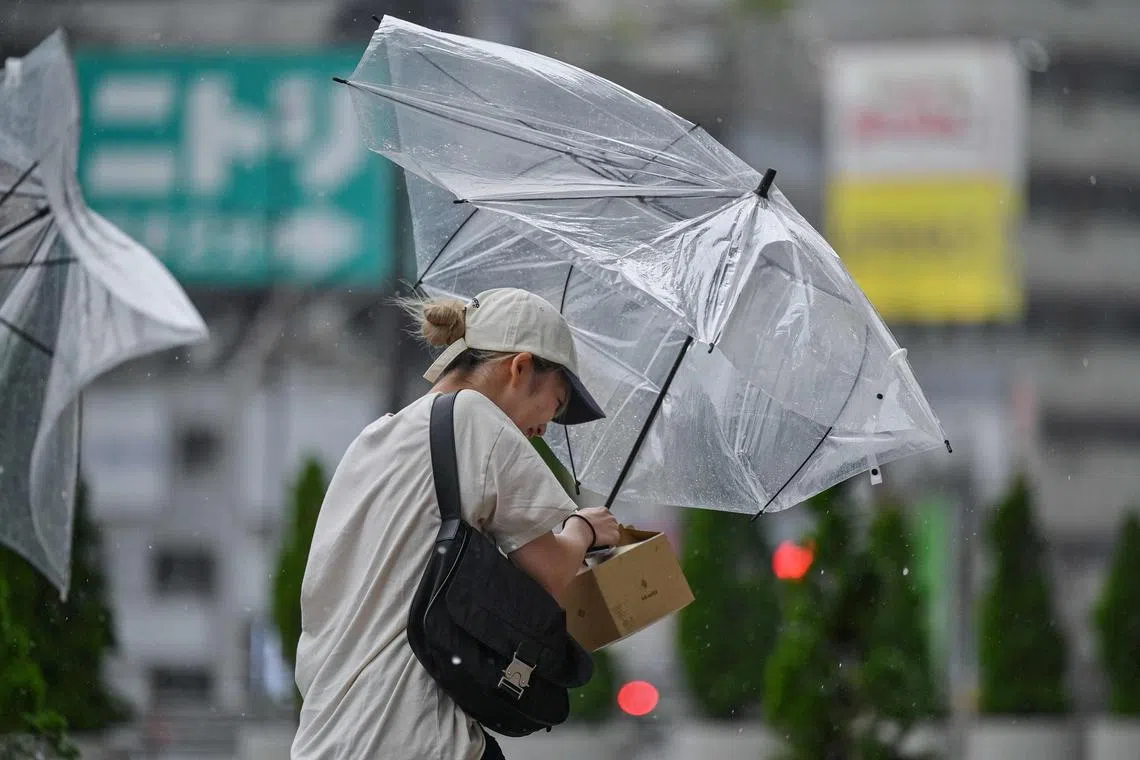‘Very strong’ typhoon Ampil buffets Japan’s Pacific coast, disrupts flights and trains
Sign up now: Get insights on Asia's fast-moving developments

Located about 170km south of Tokyo, Ampil was packing gusts of up to 216kmh as it headed north-east.
PHOTO: AFP
Follow topic:
TOKYO – Typhoon Ampil buffeted Japan’s Pacific coast with fierce winds and heavy rain on Aug 16, forcing major Japanese airlines to cancel flights and the government to issue a warning against possible landslides and flooding.
Located about 170km south of Tokyo, Ampil was packing gusts of up to 216kmh as it headed north-east, the Japan Meteorological Agency (JMA) said.
The eye of the typhoon was not expected to make landfall, instead barrelling north-eastwards up the Honshu coast and skirting the Tokyo region, home to around 40 million people, before heading back into the Pacific from Aug 17.
The JMA rated the weather system as “very strong”, one notch below its highest category of “violent typhoon”, with maximum wind speeds of 195kmh.
The agency warned people to be “on high alert for violent storms, tidal waves, landslides, flooding in low-lying lands and river floods”.
“While some people might be planning to spend leisurely time at the beach, we urge residents of potentially impacted areas to not approach the sea and rivers,” Mr Satoshi Omatsu, director of the river management office at the Ministry of Land, Infrastructure, Transport and Tourism, said at a news conference.
Risk of heavy rain-linked disasters will increase through Aug 16 in the Kanto area surrounding Tokyo and through the morning of Aug 17 in the northern Tohoku region, the JMA said in a statement.
“The Kanto region is expected to experience fierce winds that could cause injuries from flying debris or even overturn trucks in motion,” the agency warned on its website.
More than 18,000 people were advised to evacuate in Chiba prefecture east of Tokyo, the Fire and Disaster Management Agency said in a statement.
Some 2,000 households in Tokyo’s neighbouring prefectures, mainly Chiba, were without power due to the typhoon, according to the utility operator.
Japan Airlines and All Nippon Airways cancelled some 90 international flights,

All Nippon Airways and Japan Airlines cancelled some 90 international flights, affecting more than 15,000 passengers.
PHOTO: AFP
Some foreign airlines’ operations were also affected.
Korean Air Lines said 12 of its flights between Japan and South Korea would be suspended on Aug 16 and 17. Cathay Pacific Airways said its Japan flights are currently operating normally, adding that it is “closely monitoring the potential impact of severe tropical storm Ampil”.
“Customers are strongly advised to check the latest flight information on our website,” a company corporate affairs official wrote via e-mail.
Bullet train services between Tokyo and Nagoya would be halted throughout the day on Aug 16 as the typhoon brings heavy rain and strong winds, according to Central Japan Railway. Operations between Shin-Osaka and Nagoya will also be reduced.
East Japan Railway, which operates bullet trains to Aomori, Akita and Kanazawa, also said there may be disruptions on some routes in the Kanto region surrounding Tokyo. Some local trains are also planning to halt operations within Tokyo.
East Nippon Expressway, which manages expressways in the Kanto region and Hokkaido, warned that some roads may be shut from Aug 16 to 17, and asked travellers to reconsider their plans.
The typhoon comes as Japan marks the Obon holiday week, when millions return to their home towns, and days after Tropical Storm Maria dumped record rain in parts of the north.
“We will check our phones for any information on the internet and if the typhoon seems OK, then we’ll go outside,” said Mr Isamu Teruya, 47, a visitor from Saga prefecture who arrived in Tokyo on Aug 15.
“If the rain is really bad, then we will stay inside our hotel and relax,” he said.
Typhoons in the region have been forming closer to coastlines, intensifying more rapidly and lasting longer over land due to climate change, according to a study released in July.
Researchers from universities in Singapore and the United States analysed more than 64,000 modelled historic and future storms from the 19th century to the end of the 21st century to come up with the findings. BLOOMBERG, REUTERS, AFP

